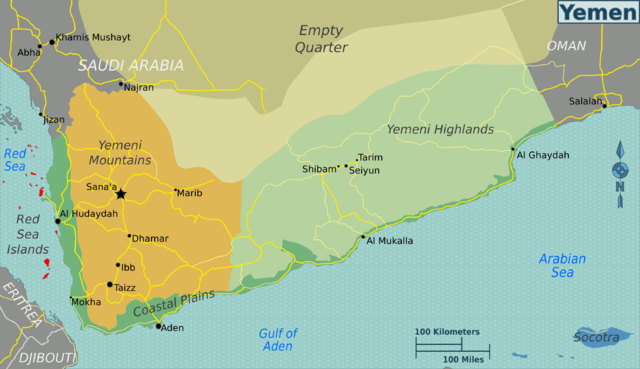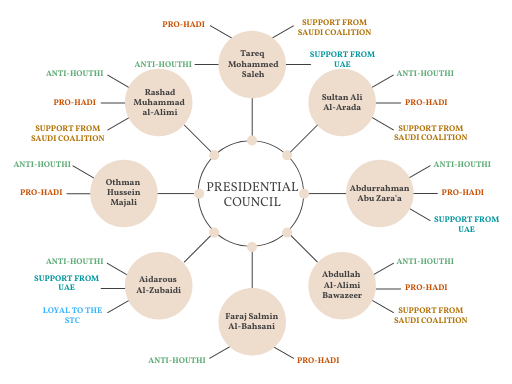 Regional Map of Yemen | Credit: Peter Fitzgerald
Regional Map of Yemen | Credit: Peter Fitzgerald
Yemen’s Peace Process: Peace at Last or Doomed to Fail?
The Civil War in Yemen has resulted in the world’s largest humanitarian crisis and aid operation, with numerous power brokers vying for influence along messy frontlines and exclaves. While mediators have attempted to broker agreements, talks have long stalled on multiple fronts. However, Yemen’s peace process progressed in April with the negotiation of a two-month ceasefire, the resignation of President Hadi, and the creation of a Presidential Council. While these developments move the needle toward peace in Yemen, the international community should measure expectations. The only common thread between council members is their shared distrust of the Houthis. To help build a lasting peace, the international community should encourage a multi-faceted and inclusive peace process that engages all levels of Yemeni society.
The Ceasefire
On April 1, 2022, the UN announced a two-month ceasefire between the Saudi-led coalition and the Houthis. Under the terms of the agreement, fuel shipments are allowed to arrive at the Hodeida Port, commercial flights can land at the Sana’a International Airport, and the truce can be renewed past its end date if both parties consent.
The Presidential Council
On April 7, in a surprise move, the internationally recognized President of Yemen, Abdrabbuh Mansur Hadi, stepped down after ten years as president. Mr. Hadi relinquished all power and authority—including that of his vice president, Ali Mohsen al-Ahmar—to the newly established Presidential Council. The Council was the culmination of a week’s worth of Yemeni-Yemeni negotiations in Riyadh, Saudi Arabia, between different anti-Houthi forces. The Council comprises eight members with clashing visions of Yemen’s future because of different priorities, intractable beliefs, and tangled alliances. Groups of complex support lines can be sorted into five broad categories: 1) Anti-Houthi, those who are against the Houthis; 2) Pro-Hadi, those who supported Hadi and the internationally recognized Cabinet of Yemen before he transferred power to the current Presidential Council; 3) those whom the Saudi Coalition supports; 4) those whom the United Arab Emirates (UAE) supports separately; finally, 5) those who have allegiance to the UAE-backed Southern Transitional Council (STC). Members include:

- Rashad Muhammad al-Alimi: The former Deputy Prime Minister for Defense and Security under President Saleh and advisor to President Hadi, who presides over the Council.
- Tareq Mohammed Saleh: Nephew of former President Ali Abdullah Saleh and leader of the pro-Hadi National Resistance Forces loyal to the Cabinet of Yemen.
- Sultan Ali Al-Arada: A prominent military figure and Governor of the Marib Governorate, where Houthi forces fight pro-Hadi forces in an ongoing military campaign. Control of this Governate is critical as it connects Houthi-controlled Sana’a and the Hadhramaut Governate.
- Abdurrahman Abu Zara’a: Leader of the Giants Brigades, a militia that is the largest faction of the Yemeni Joint Forces loyal to the Cabinet of Yemen who took back the southern oil-rich province of Shabwa from the Houthis in 2022—a significant victory.
- Abdullah Al-Alimi Bawazeer: Director of Office of the Presidency of the Republic. He is a member of President Hadi’s inner circle.
- Faraj Salmin Al-Bahsani: A military commander and Governor of the strategically valuable oil-rich Hadhramaut Governatein Eastern Yemen, where pro-Hadi and the STC are vying for influence.
- Aidarous Al-Zubaidi: President of the STC, a secessionist organization in South Yemen that ousted Hadi’s government from Aden in 2018.
- Othman Hussein Majali: A Parliamentarian and former Minister of Agriculture, a tribal leader of the Saada province in Southwest Yemen.
The Future of Peace
The recent developments in the peace process in Yemen mirror the partially implemented negotiations of the past. In 2018 the STC successfully removed the Hadi government from Aden. The Saudis intervened, reinstalled Hadi, and created the Riyadh Accords in 2019. The agreement detailed the integration of the STC into a new government; in exchange, its troops would be under Presidential command. However, full implementation of the Accords has yet to occur, signaling the enduring mistrust between partners and the agreement’s limitations—limitations reflected in the Presidential Council. Being united in mutual distaste for the Houthis may be enough in the context of the war, but it will not be enough when peace requires collaboration and a conceptual goal beyond the defeat of a common enemy. A critical factor that remains missing in current peace negotiations besides the Houthis is citizens. The international community’s focus on negotiations between leaders of the principal factions has limited other means of success. Instead, the international community must push for an inclusive and multi-tracked approach to peace that engages with citizens locally and attempts to repair broken trust through restorative justice. Bottom-up approaches such as supporting local peace initiatives and engaging local communities in dialogue can create stability at the regional level, putting pressure on primary actors to consider their people’s interests and providing a greater incentive for stability. While peace negotiations at the national level are gaining traction, peace needs to be viewed and pursued at all levels in Yemen.
Conclusion
It remains unclear how progress made towards peace in Yemen will proceed. Given the lack of progress made on the Riyadh Agreement and the significant hurdles Presidential Council members must clear, not to mention the lack of input by the Houthis and citizens, it is unlikely negotiations will be compelling. While the peace process in Yemen is not hopeless, and the current progress may provide a functional building block for peace, the international community must redefine the process to include all sectors of society. Only then, with mutual investment, can the country at war with itself finally begin to be at peace.





